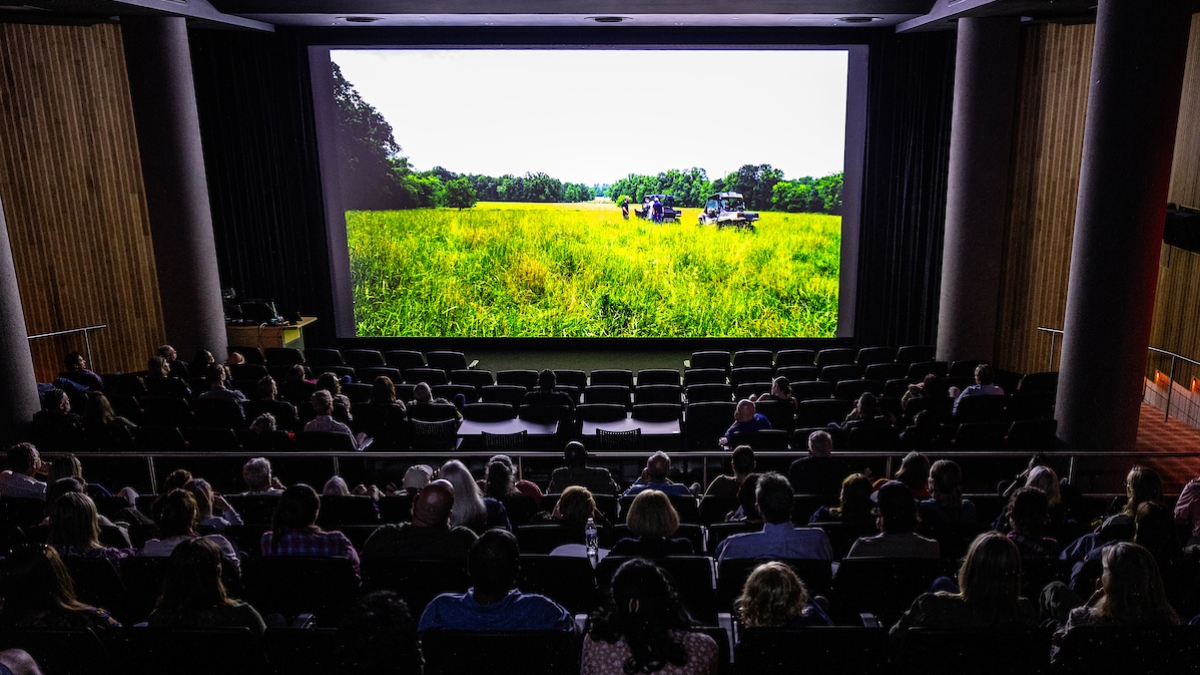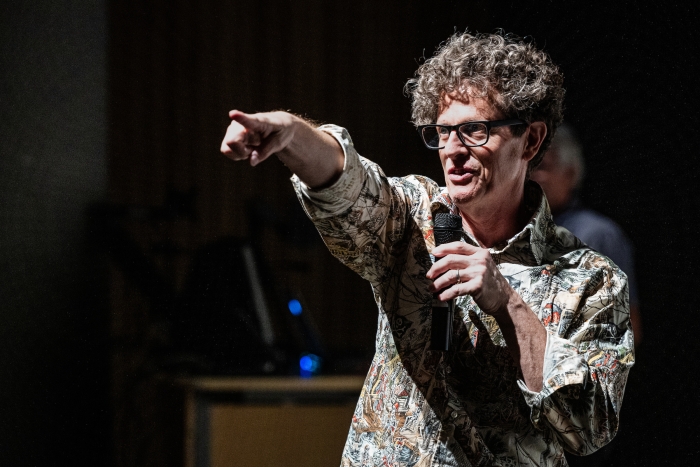Solutions to climate change grounded in grazing

The Arizona premiere of “Roots So Deep (You Can See the Devil Down There)” took place Oct. 26 at Marston Exploration Theater in ASU’s ISTB4 building on the Tempe campus. Photo by Charlie Leight/ASU News
Update: Beginning May 28, 2024, the four-part “Roots So Deep” documentary series will be available to rent at rootsodeep.org. Watch the trailer on YouTube.
____
Peter Byck has managed to do the seemingly impossible.
In a world where opinions about climate change can sometimes be polarizing, the Arizona State University professor of practice has produced a film that features farmers and scientists, with different viewpoints, discussing the carbon footprint of both conventional and regenerative cattle grazing.
(Spoiler alert: Studies show that regenerative grazing pulls down up to four times more carbon from the atmosphere than conventional grazing.)
The Arizona premiere of “Roots So Deep (You Can See the Devil Down There)” took place Thursday at the Marston Exploration Theater in ASU’s Interdisciplinary Science and Technology Building IV to a full audience and included a Q&A with Byck after the screening.
ASU President Michael Crow introduced the film via video, commending Byck for “helping us to better understand the relationship between agricultural production and climate change.”
At the heart of it is the question, “How do we actually get people to understand that if we just think a bit more comprehensively about the carbon equation, we could much better manage our relationship with the planet?” Crow said.
Digging for solutions
“Roots So Deep” was born out of Byck’s desire to find solutions to problems created by climate change.
The filmmaker heard about an underutilized system of farming known as Adaptive Multi-Paddock (AMP) grazing — a process of feeding cattle in small paddocks and moving frequently to fresh ones.
This livestock management practice allows for healthy, restorative rest periods for the land. Traditional grazing on large pastures for extended periods results in overgrazing and the depletion of nutrients from the soil.
“AMP grazing is based on the oldest ways of grazing invented by the best land managers ever — bison,” explained Byck, a professor of practice at ASU’s School of Sustainability and the Walter Cronkite School of Journalism and Mass Communication.
According to Byck’s team of scientists, AMP grazing is being used by only 3% of the country’s farmers, but has the potential to safeguard natural ecosystems and solve many environmental problems plaguing the planet.
Despite its benefits, Byck soon learned that a lack of scientific research about the method made it risky for traditional farms to consider.
That’s when he embarked on what was to be a 10-year, $10 million research project.
The farmers and the film
The “Roots So Deep” documentary brings viewers along on Byck’s adventure to the homes of farmers in Kentucky, Tennessee, Alabama and Mississippi.
The film’s rigorous research was done by a team of 20 maverick scientists across seven universities who worked on five sets of neighboring farms. They compiled data from farmers who have mastered AMP grazing, and their neighbors who continue with the conventional grazing style. Studies from the project have already appeared in nine peer-reviewed research publications.
Scientists compared insect life, cattle health and bird count. AMP grazing farms enjoyed a total of 442 birds from nine species compared with the conventional farms that had only 152 birds from six species.
They examined microbes, greenhouse gas cycling, the richness of the soil and water penetration. AMP grazing farms generated two inches more of water infiltrationHow much water soaks into the soil, as opposed to turning into runoff. than the traditional farms, which adds up to a savings of 54,000 gallons per acre, per hour.
And then there's the cow patties. The patties on one regenerative farm decomposed within days (turning into natural fertilizer), while the others remained on the farm for almost four years. At the time of the filming, they were ready for a game of frisbee.
The science of change
When asked about his uncanny ability to discuss difficult topics without division, Byck said, “I’ve learned that if you don’t call someone an idiot when they disagree with you — you are more likely to get them to listen to you.”
Ultimately, the documentary is about the process and difficulty of letting go of old ideas and embracing, or maybe just considering, new ones.
“It’s really hard to get people to change,” Byck said.
Change was one of two main reasons that Byck pursued the project.
“I set out to do two things,” he said. “First, I wanted to see if the science actually proved that one way (of farming) was better than the other. And second, even if the science is strong, would it get farmers to change?”
In the end, the farmers listened closely to the research presented by the scientists. But the money also talked.
AMP grazing eliminates the need to pay for fertilizer, which can cost up to $90,000 a year and often yields minimal results. A more balanced insect community also reduced the need for a lot of pesticides. The cattle at the AMP farms were also generally healthier and gained more weight than those at traditional farms, in part because healthier soil put more nutrients in the grass that they grazed on.
For one traditional farmer, it was the realization that their farm had no bird species while the neighboring farm had many that shocked her into action.
Byck said the project would never have been possible without the confidence of those involved.
“It took a lot of trust for an amazing team of scientists to come on board, and also the 10 farm families that allowed us to do research from 2018 to 2022,” he said.
“I hope the funders, the farmers and the scientists are all glad they said yes to this project,” Byck added. “I know I am. And it wouldn't have existed without them.”
Byck said ASU played a big role in the production of the film, which will be available for streaming in Februrary.
“To allow a filmmaker by trade to lead a large research project with scientists from all over the country is something that could only happen at ASU,” he said. “ASU is not an agriculture university. The leadership had to be open-minded enough to allow this to happen.”
More Law, journalism and politics

Cronkite School launches Women Leaders in Sports Media live-learn program
Women in a new sports media program at Arizona State University got a solid game plan from a sports veteran at an Aug. 20 welcome event.“Be humble, be consistent and be a solver,” Charli Turner…

ASU center to host the Pursuits of Education and Excellence Symposium
The Center for the Study of Race and Democracy (CSRD) at Arizona State University is introducing the Pursuits of Education and Excellence Symposium as part of an ongoing initiative to commemorate the…
ASU journalism students dominate NATAS Student Production Award nominations
Students at Arizona State University’s Walter Cronkite School of Journalism and Mass Communication dominated the nominations field of the prestigious Rocky Mountain Southwest Chapter of the National…

